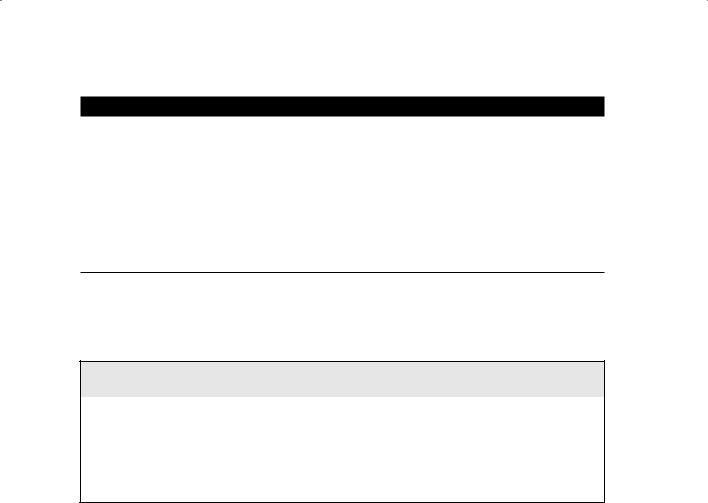
- •Acknowledgments
- •About the Author
- •Contents at a Glance
- •Contents
- •Table of Exercises
- •Introduction
- •Assessment Test
- •Answers to Assessment Test
- •Defining Ethical Hacking
- •How to Be Ethical
- •Keeping It Legal
- •Summary
- •Exam Essentials
- •Review Questions
- •Answers to Review Questions
- •Reconnaissance
- •Information-Gathering Methodology
- •Social Engineering
- •Summary
- •Exam Essentials
- •Review Questions
- •Answers to Review Questions
- •Scanning
- •Enumeration
- •Summary
- •Exam Essentials
- •Review Questions
- •Answers to Review Questions
- •The Simplest Way to Get a Password
- •Types of Passwords
- •Cracking a Password
- •Understanding Keyloggers and Other Spyware Technologies
- •Escalating Privileges
- •Understanding Rootkits
- •Hiding Files
- •Understanding Steganography Technologies
- •Summary
- •Exam Essentials
- •Review Questions
- •Answers to Review Questions
- •Trojans and Backdoors
- •Viruses and Worms
- •Summary
- •Exam Essentials
- •Review Questions
- •Answers to Review Questions
- •How a Sniffer Works
- •Sniffing Countermeasures
- •Bypassing the Limitations of Switches
- •Wireshark Filters
- •Summary
- •Exam Essentials
- •Review Questions
- •Answers to Review Questions
- •Denial of Service
- •Session Hijacking
- •Summary
- •Exam Essentials
- •Review Questions
- •Answers to Review Questions
- •How Web Servers Work
- •Types of Web Server Vulnerabilities
- •Web Application Vulnerabilities
- •Summary
- •Exam Essentials
- •Review Questions
- •Answers to Review Questions
- •SQL Injection
- •Buffer Overflows
- •Summary
- •Exam Essentials
- •Review Questions
- •Answers to Review Questions
- •Wi-Fi and Ethernet
- •Authentication and Cracking Techniques
- •Using Wireless Sniffers to Locate SSIDs
- •MAC Filters and MAC Spoofing
- •Rogue Access Points
- •Wireless Hacking Techniques
- •Securing Wireless Networks
- •Summary
- •Exam Essentials
- •Review Questions
- •Answers to Review Questions
- •Components of Physical Security
- •Understanding Physical Security
- •Physical Site Security Countermeasures
- •What to Do After a Security Breach Occurs
- •Summary
- •Exam Essentials
- •Review Questions
- •Answers to Review Questions
- •Linux Basics
- •Compiling a Linux Kernel
- •GCC Compilation Commands
- •Installing Linux Kernel Modules
- •Linux Hardening Methods
- •Summary
- •Exam Essentials
- •Review Questions
- •Answers to Review Questions
- •Types of IDSs and Evasion Techniques
- •Summary
- •Exam Essentials
- •Review Questions
- •Answers to Review Questions
- •Generating Public and Private Keys
- •Cryptography Algorithms
- •Summary
- •Exam Essentials
- •Review Questions
- •Answers to Review Questions
- •Defining Security Assessments
- •Penetration Testing
- •Pen Test Deliverables
- •Summary
- •Exam Essentials
- •Review Questions
- •Answers to Review Questions
- •Glossary
- •Index

Hiding Files |
113 |
rootkit has a hard-coded IP address (10.0.0.166) to which it will respond. The rootkit uses raw Ethernet connections to the system’s network card, so it’s very powerful. The target port doesn’t matter; a hacker can telnet to any port on the system. In addition, multiple people can log into the rootkit at once.
Rootkit Countermeasures
All rootkits require administrator access to the target system, so password security is critical. If you detect a rootkit, you should back up critical data and reinstall the operating system and applications from a trusted source. The administrator should also keep available a well-documented automated installation procedure and trusted restoration media.
Another countermeasure is to use the MD5 checksum utility. The MD5 checksum for a file is a 128-bit value, something like the file’s fingerprint. (There is a small possibility of getting two identical checksums for two different files.) This algorithm is designed so that
changing even one bit in the file data causes a different checksum value. This feature can be useful for comparing files and ensuring their integrity. Another good feature is the checksum’s fixed length, regardless of the size of the source file.
The MD5 checksum makes sure a file hasn’t changed. This can be useful in checking file integrity if a rootkit has been found on a system. Tools such as Tripwire implement MD5 checksums to identify files affected by the rootkit.
Countermeasure Tools
Tripwire is a file system integrity-checking program for Unix and Linux operating systems. In addition to one or more cryptographic checksums representing the contents of each directory and file, the Tripwire database also contains information that lets you
verify access permissions and file mode settings, the username of the file owner, the date and time the file was last accessed, and the last modification made to the item.
Hiding Files
A hacker may want to hide files on a system to prevent their detection. These files may then be used to launch an attack on the system. There are two ways to hide files in Windows. The first is to use the attrib command. To hide a file with the attrib command, type the following at the command prompt:
attrib +h [file/directory]
The second way to hide a file in Windows is with NTFS alternate data streaming. NTFS file systems used by Windows NT, 2000, and XP have a feature called alternate data streams

114 Chapter 4 n System Hacking
that allow data to be stored in hidden files linked to a normal, visible file. Streams aren’t limited in size; more than one stream can be linked to a normal file.
NTFS File Streaming
NTFS file streaming allows a hidden file to be created within a legitimate file. The hidden file does not appear in a directory listing but the legitimate file does. A user would usually not suspect the legitimate file, but the hidden file can be used to store or transmit information. In Exercise 4.2, you’ll learn how to hide files using NTFS file streaming.
E x e r c i s e 4 . 2
Hiding Files Using NTFS File Streaming
Note: This exercise will only work on systems using the NTFS file system.
To create and test an NTFS file stream:
1.At the command line, enter notepad test.txt.
2.Put some data in the file, save the file, and close Notepad. Step 1 will open Notepad.
3.At the command line, enter dir test.txt and note the file size.
4.At the command line, enter notepad test.txt:hidden.txt. Type some text into Notepad, save the file, and close it.
5.Check the file size again (it should be the same as in step 3).
6.Open test.txt. You see only the original data.
7.Enter type test.txt:hidden.txt at the command line. A syntax error message is displayed.
Hacking Tool
makestrm.exe is a utility that moves the data from a file to an alternate data stream linked to the original file.
NTFS Stream Countermeasures
To delete a stream file, copy the first file to a FAT partition, and then copy it back to an NTFS partition.
Streams are lost when the file is moved to a FAT partition because they’re a feature of NTFS and therefore exist only on an NTFS partition.

Understanding Steganography Technologies |
115 |
Countermeasure Tool
You can use lns.exe to detect NTFS streams. LNS reports the existence and location of files that contain alternate data streams.
Understanding Steganography
Technologies
Steganography is the process of hiding data in other types of data such as images or text files. The most popular method of hiding data in files is to utilize graphic images as hiding places. Attackers can embed any information in a graphic file using steganography. The hacker can hide directions on making a bomb, a secret bank account number, or answers to a test. Any text imaginable can be hidden in an image. In Exercise 4.3 you will use Image Hide to hide text within an image.
Hacking Tools
ImageHide is a steganography program that hides large amounts of text in images. Even after adding bytes of data, there is no increase in the image size. The image looks the same in a normal graphics program. It loads and saves to files and therefore is able to bypass most email sniffers.
Blindside is a steganography application that hides information inside BMP (bitmap) images. It’s a command-line utility.
MP3Stego hides information in MP3 files during the compression process. The data is compressed, encrypted, and then hidden in the MP3 bitstream.
Snow is a whitespace steganography program that conceals messages in ASCII text by appending whitespace to the end of lines. Because spaces and tabs generally aren’t visible in text viewers, the message is effectively hidden from casual observers. If the built-in encryption is used, the message can’t be read even if it’s detected.
CameraShy works with Windows and Internet Explorer and lets users share censored or sensitive information stored in an ordinary GIF image.
Stealth is a filtering tool for PGP files. It strips off identifying information from the header, after which the file can be used for steganography.

116 Chapter 4 n System Hacking
E x e r c i s e 4 . 3
Hiding Data in an Image Using ImageHide
To hide data in an image using ImageHide:
1.Download and install the ImageHide program.
2.Add an image in the Image Hide program.
3.Add text in the field at the bottom of the ImageHide screen.
4.Hide the text within the image using ImageHide.
Steganography can be detected by some programs, although doing so is difficult. The first step in detection is to locate files with hidden text, which can be done by analyzing patterns in the images and changes to the color palette.
Countermeasure Tools
Stegdetect is an automated tool for detecting steganographic content in images. It’s capable of detecting different steganographic methods to embed hidden information in JPEG images.
Dskprobe is a tool on the Windows 2000 installation CD. It’s a low-level hard-disk scanner that can detect steganography.
Covering Your Tracks and
Erasing Evidence
Once intruders have successfully gained administrator access on a system, they try to cover their tracks to prevent detection of their presence (either current or past) on the system.
A hacker may also try to remove evidence of their identity or activities on the system to prevent tracing of their identity or location by authorities. To prevent detection, the hacker usually erases any error messages or security events that have been logged. Disabling auditing and clearing the event log are two methods used by a hacker to cover their tracks and avoid detection.
The first thing intruders do after gaining administrator privileges is disable auditing. Windows auditing records certain events in a log file that is stored in the Windows Event Viewer. Events can include logging into the system, an application, or an event log. An administrator can choose the level of logging implemented on a system. Hackers want to
